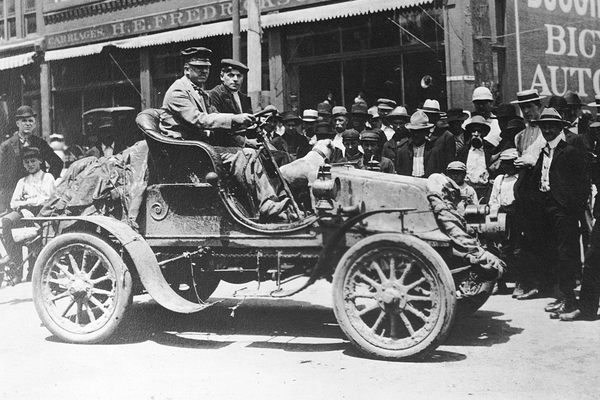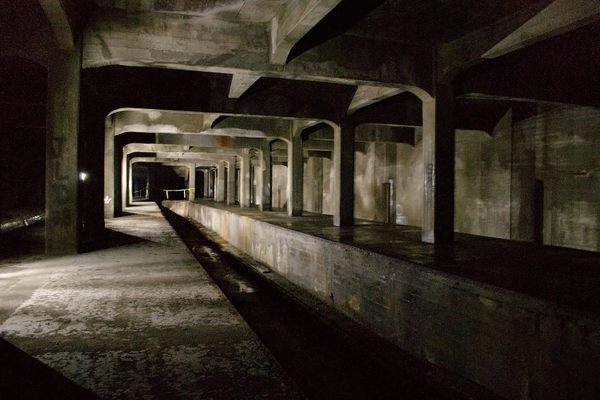The Planes, Soviet Trains, and Rare Automobiles of North Korea
The entire country of North Korea has fewer paved roads than the city of Detroit — about one car for every thousand people — and a chronic shortage of petroleum fuel. That’s the transportation situation for the nearly 25 million people. So how do they get around?
Children in North Korea: a good socialist never takes more wheels than she needs (photograph by stephan/Flickr user)
International Travel
As the world’s most isolated country, there are very few links between North Korea and the outside world. Most foreigners travel in and out of the country by air, through the Pyongyang Sunan International Airport. National carrier Air Koryo operates regular flights from Beijing and several other Asian cities. Air Koryo has the distinction of being the world’s only “1-star” airline out of the 681 reviewed by rating service Skytrax.
Air Koryo (photograph by Laika ac/Flickr user)
In-flight meal service on North Korea’s national airline (photo by Kristoferb)
Arriving in Pyongyang Sunan Airport (photograph by calflier001/Flickr user)
Almost no automobile traffic crosses the North Korean border. The Sino-Korean Friendship Bridge provides a one-lane vehicular route from DPRK into Dandong, China, but the majority of the traffic over the bridge is by rail. Pedestrian traffic is entirely forbidden, and the entrance is heavily guarded on the North Korean side. Most defectors who escape the country cross the border in this area on foot, often swimming across the Yalu or Tumen rivers under the cover of darkness.
View from the Chinese side of the Sino-Korean Friendship Bridge (photograph by Prince Roy)
View of the bridge from the water (photograph by Marie/Flickr user)
Automobiles
Cars and trucks are a scarce commodity in North Korea. In a 2007 interview, Andrei Lankov, a Seoul-based North Korea expert, estimated that there were only between 20,000 and 25,000 passenger cars in the entire country. Owning a private car is “pretty much what a private jet is to the ordinary American,” according to Lankov.
A Romanian-built Dacia 1310 in North Korea. The black license plates indicate state ownership (photo by Roman Harak)
Driving in Pyongyang, with the May Day Stadium in the background (photograph by stephan/Flickr user)
On large highways, the speed limit varies by lane — and which lane you can travel in depends on your status. The far left lane is reserved for senior government and military officials, who can zip along at 43 mph, while regular folks on the far right are restricted to 24 mph.
According to exile news site New Focus International, North Korean traffic police are the most ready source of gasoline and diesel for those without a connection to military supplies. Police use their enforcement authority to solicit bribes from drivers, and then demand on-the-spot payment in the form of siphoned fuel — a hot commodity in the underground barter market.
A traffic director in Kaesong, North Korea, a common sight in cities as they’re cheaper to hire than power traffic lights (photograph by yeowatzup/Flickr user)
Trains
Experts believe the majority of passengers and cargo get around by means of the country’s extensive railway network. Rail infrastructure may be one of the only measures of economic development where North Korea outranks the South, In 2009, the CIA reported about 5,200 km of railroad track across North Korea’s 46,000 square miles, compared to 3,300 kilometers in the South.
Kim Il-Sung, who founded the country in 1948 and ruled until his death in 1994, was a big fan of train travel. His son, Kim Jong Il, was famously afraid of flying. He was reported to have six personal trains, which he deployed in convoys of three to travel among his 19 private rail stations around the country. According to state media, he died while on one of these train trips in 2011. Kim Jong-Un has broken with tradition, choosing to travel in a Russian made IL-62 — a passenger jet comparable to a 747.
For those not traveling with the Presidential entourage, rail accommodations range from Soviet chic to homemade death trap.
A Soviet M62 diesel locomotive in use in North Korea (photograph by Clay Gilliland)
Pyongyang Railway Station, with a Soviet-era diesel procured from the GDR (photograph by Clay Gilliland)
At the death trap end of the spectrum are improvised train cars people use to move themselves and goods around the countryside. Essentially they are homemade carts and platforms, sometimes powered by old tractor or motorcycle engines, and rigged to run on existing rail lines.
Trams, Trolleys, Buses, and Subways
Because both cars and fuel are so rare, North Korean cities are heavily reliant on electrically powered public transportation. In the capital and a few other large cities there are tram and trolleybus systems powered by overhead electrical lines, mostly running ancient buses and equipment from the Soviet Union.
A North Korean-made Cholima 9.25 tram crossing Kim Il-Sung Square (photo by Laika ac/Flickr user)
Bus in North Korea (photograph by Roman Harak)
The pride of the Pyongyang transit system is its subway. The Pyongyang Metro connects 16 stations over 24km of track. Apparently there used to be 17 stations, but one was converted into a mausoleum to house the remains of the Eternal Leader Kim Il Sung. So the trains don’t stop there anymore. Up to 700,000 riders a day use the system to get around Pyongyang, with tickets priced at a relatively affordable $0.03 U.S. cents.
Yonggwang Station on the Pyongyang Metro; the cars were originally used in Berlin (photograph by John Pavelka)
Puhung Station in Pyongyang (photograph by John Pavelka)
Mosaic mural of “The Great Leader Comrade Kim Il Sung Among Workers” in Puhung Station (photograph by John Pavelka)
It is among the deepest metro systems in the world, with sections over 350 feet below ground, likely because the network is intended for military use in addition to public transit. The stations were designed to be convertible into bomb shelters, with heavy steel blast doors and inspiring socialist murals. It is widely believed that there other, secret lines on the system reserved for government and military use. North Korea is known to have a number of underground military installations, and the metro is likely used to link these installations.
Statue in the Pyongyang Metro (photograph by Clay Gilliland)
Station controller in the Pyongyang Metro (photograph by Laika ac/Flickr user)
Descending deep into the Puhung station of the Pyongyang Metro (photograph by Bjørn Christian Tørrissen)
Bicycles
Bicycles are probably the most common mode of transportation for average North Koreans. Until fairly recently bikes were considered a status symbol and a bit of a luxury item. But with the rise of grey market trading in the last 10-15 years, bicycles have become an economic necessity. Household bike ownership rates shot from 40 percent to over 70 percent by 2008. At that time, prices ranged from about $11-$22 dollars U.S. for a used bicycle, with the best Japanese models going into the $70 and $80 range.
Man cycling by the Taedong River; Grand People’s Study House in background (photograph by Kok Leng Yeo)
So it was a big deal in 1996 when women were banned from riding bikes in North Korea — allegedly after a senior official’s daughter was killed in a cycling accident. Current leader Kim Jong Un briefly lifted the ban after coming to power, but it was reinstated a few months later. State media have suggested the image of a woman on a bike is “contrary to socialist morals,” but reports from tourists and others suggest enforcement is spotty in the countryside.
Mural of Kim Il-sung & Kim Jong-il in Gaeseong (photograph by Nicor/Wikimedia)
Street in Kaesong (photograph by Nicor/Wikimedia)












Follow us on Twitter to get the latest on the world's hidden wonders.
Like us on Facebook to get the latest on the world's hidden wonders.
Follow us on Twitter Like us on Facebook